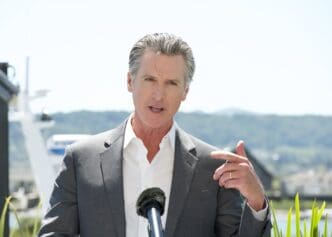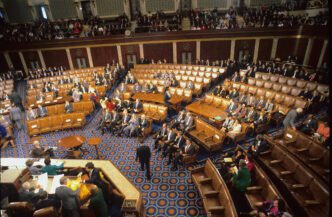Executive Summary
- California Governor Gavin Newsom has adopted a communication style mirroring President Trump’s, using all capital letters in social media posts and coining nicknames, to directly challenge Trump and rally Democratic support.
- This assertive approach is resonating with Democrats, who are eager to see party members directly challenge President Trump and view Newsom’s engagement as “refreshing, energizing and even fun to watch.”
- While Democrats praise the strategy as an effective “attention-grabbing tactic” that targets President Trump and the media, Republicans question its long-term impact on substantive policy debates and the party’s national brand beyond generating online engagement.
The Story So Far
- The Democratic Party has been experiencing a period of low national popularity, leading to a desire among its base for more assertive engagement and direct challenges to President Trump. Governor Newsom’s adoption of a confrontational communication style, mirroring that of Trump, serves to energize this segment of the party and potentially elevate his profile for future political aspirations.
Why This Matters
- Governor Newsom’s adoption of a confrontational communication style, mirroring President Trump’s tactics, has successfully energized a segment of the Democratic base eager for a more assertive political approach, significantly elevating Newsom’s national profile and media attention. However, this strategy sparks a debate among political strategists regarding its long-term efficacy in driving substantive policy discussions or improving the Democratic Party’s broader national brand beyond generating immediate engagement.
Who Thinks What?
- California Governor Gavin Newsom has adopted a communication style mirroring President Trump, utilizing tactics like all-caps social media posts and coining nicknames, with the aim of directly challenging Trump and energizing support within the Democratic Party.
- Democratic strategists, such as Jamal Simmons and Anthony Coley, view Newsom’s assertive approach as refreshing and energizing, believing it resonates with Democrats who are eager to see party members directly challenge President Trump.
- Republican strategist Kevin Madden expresses skepticism regarding Newsom’s communication tactics, questioning whether focusing on such strategies over substantive messaging truly shifts public debate or improves the national party brand beyond generating online engagement.
California Governor Gavin Newsom has adopted a communication style mirroring that of President Trump, a strategy that has garnered significant media attention and energized Democrats. This approach, which includes using all capital letters in social media posts and coining nicknames, aims to directly challenge President Trump and rally support within his own party.
Newsom’s Adopted Tactics
In recent days, Governor Newsom has notably promoted his own “beautiful” midterm redistricting proposal and rallies, echoing President Trump’s characteristic language. He has also begun writing social media posts in all capital letters, similar to President Trump’s style. Additionally, Newsom has introduced the acronym “TACO,” short for Trump Always Chickens Out, a term that reportedly originated on Wall Street in response to Trump’s moves on tariffs.
This strategy has drawn attention from various media outlets, with publications like HuffPost featuring Newsom’s efforts. Fox News also commented on his imitation of President Trump during a segment on “The Five.”
Democratic Reception and Party Dynamics
Democratic strategists, including Jamal Simmons, who served as Kamala Harris’s communications director, suggest this assertive approach is resonating with Democrats. Simmons noted that Democrats are “over being the ‘nice guy’ party” and are eager to see members of their party directly challenge President Trump.
Anthony Coley, a Democratic strategist who served in the Biden administration, agreed, finding Newsom’s engagement with Trump on social media “refreshing, energizing and even fun to watch.” This strategy comes as Democrats have faced challenges in national popularity, with a Wall Street Journal poll indicating their popularity at a three-decade low.
Simmons and other strategists believe Newsom’s tactics have provided the party with a “shot in the arm,” capturing the attention of both political insiders and the general public. An Echelon Insights survey from mid-August, a period when Newsom was prominent in headlines, showed him in second place among likely 2028 candidates, behind Vice President Harris.
Continued Engagement and Republican Criticism
Newsom’s press office has continued to employ these Trump-like tactics, not only targeting President Trump but also Vice President Vance. One instance involved editing a photo of Vice President Vance onto the body of Australian breakdancer Rachael “Raygun” Gunn.
The office also engaged with other Republicans, including former White House press secretary and current television host Dana Perino, after she criticized Newsom for being “unserious.” Perino suggested Newsom’s social media activity was making a “fool” of himself and advised him to be “a little more serious” if he aspired to a “bigger job.”
Despite the growing support for Newsom’s social media presence, evidenced by his press office’s X account accumulating nearly 400,000 followers, Republican strategist Kevin Madden has voiced skepticism. Madden argued that Democrats might be mistaken in focusing on “communications tactics” over substantive “messaging.” He questioned whether Newsom’s new podcast and aggressive social media presence have truly “shifted the dynamics or public debate in his favor” or “improved the national party brand” beyond generating “clicks and downloads.”
Democratic strategist Christy Setzer views Newsom’s “trolling” strategy as targeting two primary audiences: Democrats seeking a strong challenger to President Trump and a media that Democrats feel has normalized aspects of Trump’s behavior. Setzer called the strategy “pretty brilliant,” noting its success as an “attention-grabbing tactic” and speculating on its potential impact on President Trump’s own communication style.
Governor Newsom’s adoption of a confrontational, Trump-esque communication style has positioned him as a prominent figure within the Democratic Party, drawing significant media attention and energizing a segment of the Democratic base. While the strategy has garnered praise from some Democrats as an effective way to engage President Trump, Republicans question its long-term impact on substantive policy debates and the party’s broader national brand.








